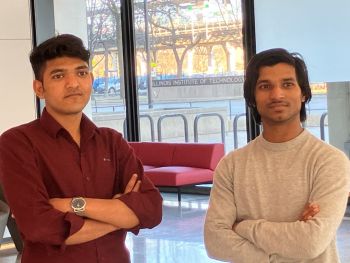Illinois Tech Professor Thomas C. Irving Honored as American Association for the Advancement of Science Fellow

CHICAGO, January 26, 2022 —Illinois Institute of Technology biology and physics professor Thomas C. Irving has been named a fellow of the American Association for the Advancement of Science (AAAS).
Irving is being honored for “distinguished contributions to the field of muscle diffraction and enabling the fields of synchrotron fiber diffraction and biological small angle scattering.” He is among the 564 scientists, engineers, and innovators spanning 24 scientific disciplines being recognized for their scientifically and socially distinguished achievements in this year’s AAAS fellows class.
AAAS is the world’s largest general scientific society, and publisher of the Science family of journals. Fellows are nominated each year by current AAAS fellows and steering groups of the association’s 24 sections representing each scientific discipline.
“It’s gratifying. It acknowledges all the work I’ve done over the years, and it feels good to be recognized by my peers,” Irving says.
Over the course of his career, Irving has become an international leader in the use of small-angle X-ray diffraction, which allows scientists to study molecular-level information in tissue to further understand illnesses such as heart disease, cancer, and neurodegenerative diseases including Alzheimer’s. Irving focuses his research on muscle structure and function, including how the body regulates muscle contractions. This is key to understanding muscle diseases such as cardiomyopathy and rare, skeletal muscle diseases like Duchenne muscular dystrophy that don’t have effective medical treatments.
“What the X-ray diffraction allows us to do is actually see these groups of molecules move at the same time they’re actually generating force,” Irving says. “We can actually see what’s going on with the molecules that are generating the force and seeing how they’re being turned on and off and under what conditions.”
As director of the Biophysics Collaborative Access Team (BioCAT) at the Advanced Photon Source (APS) at Argonne National Laboratory for the past 21 years, Irving has brought together scientists from around the world to the facility for biomedical research projects. BioCAT uses the most intense X-ray beams in the Western Hemisphere for the study of non-crystalline biological materials such as muscle, connective tissue, amyloids, viruses, proteins, and other large biological molecules and their complexes. While there are smaller international facilities that perform muscle experiments, BioCAT is also the only facility in the world with a muscle X-ray diffraction program.
Irving earned his bachelor’s, master’s, and doctoral degrees in biophysics from the University of Guelph. In addition to AAAS, he is a member of the American Crystallographic Association, American Physical Society Division of Biological Physics, Biophysical Society, Sigma Xi, and American Heart Association.
When Irving was an undergraduate, X-ray diffraction experiments with muscle were new technology; his undergraduate senior project involved lobster muscles. In the early 1990s, he worked with pioneer in muscle physiology Hugh Huxley. Recently, scientists have been able to access human tissue from tissue banks, which Irving says will have an enormous impact on future research because they’ll be able to examine real disease rather than model systems in animals.
“Lab rats, they're all genetically identical, but people are all over the place. The variability is huge so that’s actually a huge challenge to overcome in trying to study human disease,” he says. “We need to have a lot more of these studies. We need more people doing this kind of work.”
For more information on Irving’s research and the AAAS honor, click here for our news story.
For more information on the class of 2021 AAAS fellows, click here for the AAAS news release.



